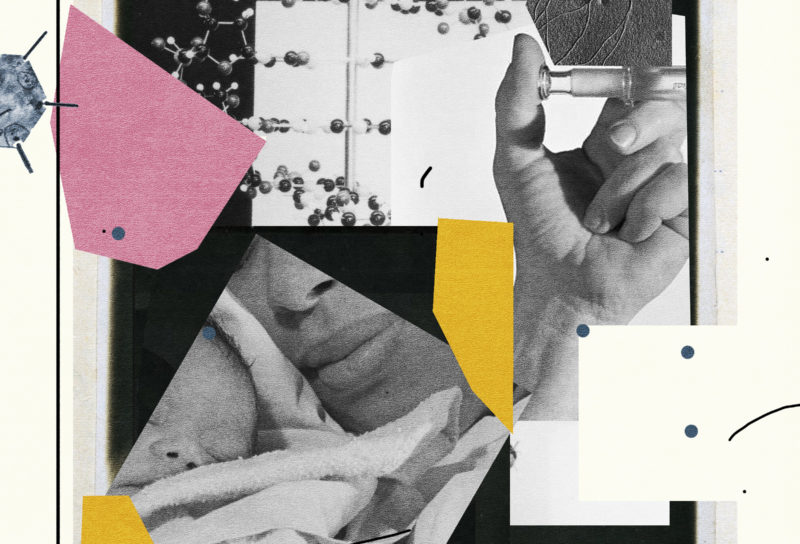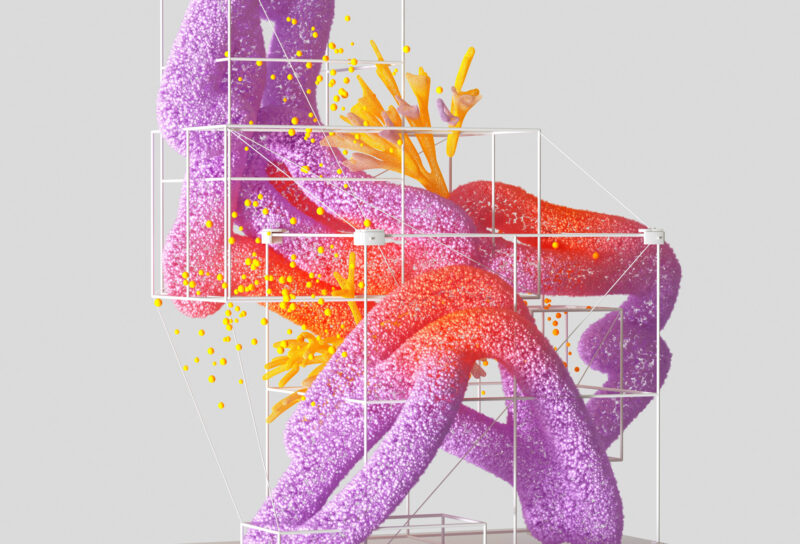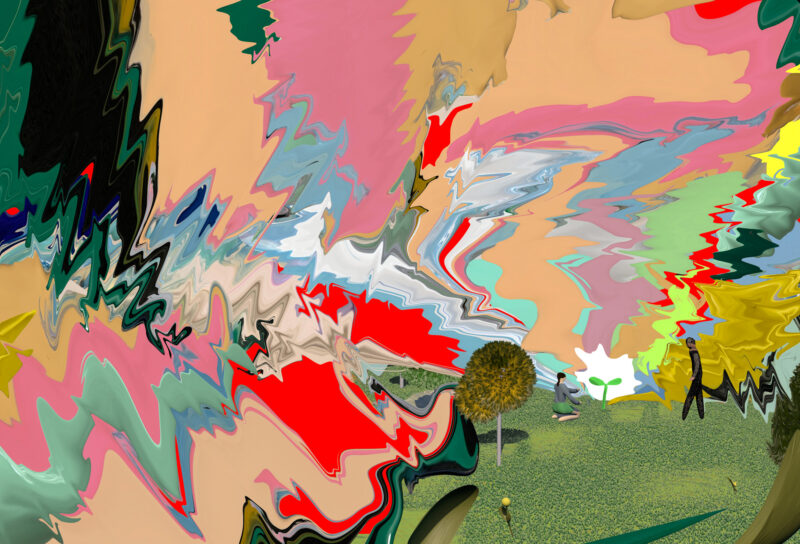It’s been raining hard all week, but today the sky is clear, and the light falling through Antoni Leewenhoek’s casement windows radiates with the milky-white holiness of the finest painting by Vermeer. Outside, the cherry and apple trees shimmer with raindrops; boat traffic glides along the swollen canal; vendors and children shout across the market square; the painted facade of Delft’s stuidhaus gleams a dull gold.
Leewenhoek, the great microscopist, has left a pot out in the rain. It’s not fine pottery—an example of the hand-painted porcelain for which the port city of Delft is already well-known in 1675—but a plain earthenware tub, painted blue. A finger of rainwater has pooled in the tub, and it sits in the courtyard, warming in the autumn sun, reflecting the sky. He can see it from the window of his third-floor study, its glassy reflection against the brick a lens onto a blue world.
Could there be anything so plain and pretty as a tub of water in a courtyard?
Writing about the Dutch masters, art critic Eugène Fromentin praised their “love for the real,” the way their unadorned scenes radiated beauty and significance. Perhaps Leewenhoek shared with his countrymen an eye for the possibilities latent in everyday things; perhaps he saw only a courtyard in need of tidying. We’ll never know what he was thinking as scooped water from the pot, as he pipetted a single drop behind the view-hole of his handmade microscope. We don’t know what impulse moved him to bring it to his eye, to hold it against the light. We only know what he saw there.
“I discovered living creatures in rain,” he wrote in his journal, that September day.
Ten years prior, in 1665, the British natural philosopher Robert Hooke published Micrographia, a book featuring lavish illustrations of insects, plants, and various textiles seen through a compound microscope. Its rendering of a house flea, “adorn’d with a curiously polish’d suite of sable Armour, neatly jointed,” occupied a 16-inch fold-out page. It was an instant bestseller, fanning a growing interest in the new science of optics. Throughout Europe, market vendors shilled spectacles and “flea glasses,” while cloth merchants used convex lenses to examine fine fabrics. Telescopes opened the night sky to Galileo. The Northern masters started using camera obscuras, mirrors, and other optical devices to paint with staggering realism. The famously distractible diarist Samuel Pepys stayed awake until 2AM with his copy of Micrographia, calling it the “most ingenious book that ever I read in my life.”
Leeuwenhoek is ingenious too, but he’s not famous—not yet. He’s not conversant in Latin or Greek, or the product of a prestigious university; he’s the son of several generations of basket-makers. He sells fabric out of a shop on the Hippolytusbuurt. He serves as a local chamberlain, surveyor, and wine-gauger, but his influence ends at the city gates of Delft, which he rarely exits, save for the occasional seaside holiday in Brabant or Schevelingen, where he can hardly suntan without breaking into a rash. For company, he keeps a dog (long-haired) and a parrot (prone to molting). As his biographer notes, with palpable tenderness, he’s the type to toss bread to the sparrows when snow is on the ground.
Robert Hooke’s microscope might be recognizable to a modern viewer; it has an eyepiece, a barrel, a knob for focusing. It’s capable of magnifying objects to about 50 times their size, making elephants of house fleas and revealing the hidden textures of ordinary things. Leeuwenhoek’s microscope, on the other hand, doesn’t look like a microscope at all: his lens is a pea-sized bead of glass sandwiched in a flat brass frame. To use the microscope, which is the size and shape of a business card, Leeuwenhoek holds the frame against a slat of light, and, squinting hard with one eye, peers through the lens. On the other side, on the needle tip of an adjustable brass pin, swimming in a raindrop, a previously-unseen microscopic world awaits.
“I discovered living creatures in rain,” he wrote in his journal, that September day.
It is a zoo of unknown creatures. Some seem to be “globules,” translucent orbs held together by an imperceivable membrane; others are oval-shaped, flat-bellied, with “divers incredibly thin little feet.” Some are a thousand times smaller than the eye of a water louse; others are comparatively monstrous. They stir, stretch, and swim around the vast expanse of the raindrop, maneuvering around with stubby paws and coiled tails no thicker, to his eye, than a spiderweb. “These little animals were the most wretched creatures that I have ever seen,” Leeuwenhoek writes in his notebook, observing a tangle of bell-shaped Vorticella spinning like whip-tops through the water. Their bodies are as yielding as a bladder-bag and burst in tiny splashes of “watery humour” when left to dry. Unsure what to call such creatures, Leeuwenhoek settles on “animalcules:” Latin for “little animals.”
They are everywhere. In the spittle of a child; in plaque scraped from the molar of an old man; in the “juice” of fresh mussels and oysters; in bile drawn from cows, sheep, and rabbits purchased on the market square. Leeuwenhoek carries his microscope with him when he goes to ride his horse, so that he can examine her urine. He examines his own semen six heartbeats after “conjugal coitus” with his second wife, Cornelia, and is shocked to find it brimming with long-tailed animalcules. At midsummer, as the poplar and linden trees lining the canals of Delft shed their blossoms into the water, he squeezes warm shit from freshly-killed chickens and pigeons to glimpse their intestinal protozoa and bacteria, which he describes as a riot of little snakes and eels. He leaves no stone unturned—not even his own, after a meal of greasy sausage.
These surveys reveal a universe so vast and populous that it’s strenuous to catalog. “In narrowly scrutinizing 3 or 4 drops I may do such a deal of work,” he writes, “that I put myself into a sweat.” Lighting is limited to sun and candle-light; holding the instrument close, his hand trembles, his lens fogs.
Leeuwenhoek made some 500 microscopes in his lifetime; only nine survive. With their tiny focal distance and even tinier lenses, Leeuwenhoek microscopes must be held close, practically inside of the eyelashes. Steven Ruzin, emeritus curator of the Golub Collection of antique microscopes at UC Berkeley, has seen through one. It was the last authenticated Leeuwenhoek to be found, back in 2015. The field of view was small, dim, and vignetted, warped at its edges by optical aberrations. And yet, Ruzin says, “it was a religious experience” to look through the same lens as Leeuwenhoek, and to see, on the other end, the blunt brass pin—“the famous pin!”—to which the Dutch master affixed his samples.
In glass cases at Berkeley, the microscope collection Ruzin stewards reveals a progression from simple hand lenses and box microscopes to compound microscopes and confocal lenses, iterations in design that brought the living world closer and closer over the centuries. The collection dead-ends in the early 1900s, not long after the German physicist Ernst Abbe posited that the smallest resolvable distance between two points using a conventional microscope could never be smaller than half the wavelength of the imaging light. The Abbe limit of resolution—about 250 nanometers—was long considered an intractable threshold in optical microscopy. But today, “super-resolution”—combining computational techniques and the extensive use of specialized dyes and fluorescent molecules that can be activated, measured, and mapped—has pushed optical microscopy far beyond Abbe, into the 3-nanometer range, with the most common techniques revealing some 25-nanometer-scale resolution.
“Too myopically close,” says Ruzin, who spent most of his career managing the Biological Imaging Facility at UC Berkeley. “I would never want one of these super, super-duper resolution microscopes in the lab, because no one would use it.”
For many biologists, there’s a Goldilocks point for magnification: close enough to see the elements of life, but far enough that they can still be observed in context, with minimal intervention, and—most importantly—alive. Electron microscopy, which takes advantage of the shorter wavelength of electrons to sidestep the resolution constraints of light, requires its samples be killed with formaldehyde, dehydrated, fixed in epoxy, sliced 60 nanometers thick, and viewed in a vacuum. This is a highly specialized technique, and although it reveals the world at a mind-boggling 1,000,000x scale, it also alters the very things it helps scientists to see—killing organisms and reducing their messy, three-dimensional, dynamic existence to a mute slice of plastic.
The history of microscopic imaging is full of such compromises. To see beyond the visible, microscopists have impregnated their samples with heavy metals, tagged them with reactive dyes, stained and frozen them, sliced them like sausages. Most living things worth seeing are transparent, and must be dyed to be visible at all. Often, what’s seen under a microscope is as much an artifact of its preparation as it is a true picture of how the sample might appear in nature. And all measurements cause perturbation—even plain old visible light alters the behavior of living things. How can we know, for sure, that what we’re seeing under the microscope isn’t reacting to the condition of being seen? “The Heisenberg uncertainty principle of microscopy,” Ruzin sighs. “It’s so defeatist—nobody even wants to think about it. Because why do any science if, by looking at something, it changes?”
Antoni van Leeuwenhoek never published scientific papers or wrote any books. He shared his findings in descriptive and frequently meandering correspondence written in Low Dutch. Between 1673 and his death in 1723, he sent some 200 letters to the Royal Society in London, most of which were published in the Society’s journal, Philosophical Transactions. He set down his observations with “childish and charming simplicity,” feeling no embarrassment about detailing the specifics of his own effluvia for the learned gentlemen of the Royal Society. “It never occurred to him that Truth could appear indecent,” writes his biographer, Clifford Dobell.
But Leeuwenhoek did withhold one truth: how he built his microscopes. “My method for seeing the very smallest animalcule, I do not impart to others,” he insisted— not the draftsmen he employed to illustrate his observations, not Robert Hooke, not even Peter the Great, Tsar of Russia, who came to Delft in a canal yacht for a three-hour tête-à-tête with the great microscopist. Taking a cue from the secretive guilds of painters and artisans surrounding him, Leeuwenhoek protected his process. The secret of his lenses remained unknown until 2021, when a team in Delft used a neutron tomography scanner to image one of his surviving original microscopes. Their scan revealed a hidden stem poking out from the lens: proof, after three centuries, that Leewenhoek didn’t grind his lenses but rather formed them carefully over a flame from a gossamer thread of Venice glass.
And so science was forced to take Leeuwenhoek at his word. This is surprising considering the official motto of the Royal Society, which reflected its focus on empirical methods: Nullius in verba. That is to say, don’t take anybody’s word for it. See for yourself.
Microscopes extended human vision beyond biological limitations. But rather than gods, they made us ladybugs.
Seeing for yourself is easier said than done. When I toured the California NanoSystems Institute, an integrative microscopy facility at UCLA, with Adam Stieg, its associate director, and Laurent Bentolila, director of its Advanced Light Microscopy lab, nothing I saw there looked like a microscope in any traditional sense. There were no glass slides and few eyepieces to look through. A cutting-edge Transmission Electron Microscope the size of a minivan was as sleek and featureless as an Apple product. In an adjoining room, a scanning probe microscope, blanketed in heat tape and tinfoil, looked like some Soviet sci-fi gizmo. In his optical lab, surrounded by pipettes, pliers, and 3D-printer filament, Bentolila showed me a flat microscope purpose-built to image living organisms like tiny zebrafish and fruit flies with scanning sheets of laser light. “The modern microscopist has far more amazing tricks than the most imaginative of armchair students of perception,” writes the philosopher of science Ian Hacking, who argues that we don’t really see through microscopes at all, but rather with them.
Like eyepieces themselves, “seeing” in microscopy is largely vestigial at this point, shorthand for far more complex processes of detection and measurement. Microscopic images are reconstituted from data gathered with the help of lasers, electron beams, and the sensitive nanoscale tips of scanning probes, which resolve the surfaces of materials through touch-like needles in a record groove. “When we talk about microscopy, we think about nice images,” explains Bentolila. “But we can also use an optical microscope, or any microscope, to sense and probe at the molecular level. A microscope itself can be used as a biometric reader. It’s something that you can measure interactions with. And you don’t need an image for that—just a signal.” While Leeuwenhoek glimpsed beyond the visible with his powerful hand lenses, centuries later, his inheritors have transcended the image entirely, “seeing” in data itself.
Historians have argued that the popularity of microscopes in the late 17th century followed a sea-change in worldview. No longer were scholars content to infer the laws of nature from ancient texts. For the new science, they sought something tangible, drawn from careful observation of the world’s most minute structures. Francis Bacon, often invoked as a guiding influence on the Royal Society, urged learned men to reject the Aristotelian anticipatio naturae (“anticipation of nature”) in favor of interpretatio naturae (“interpretation of nature”), a more methodical process of conducting experiments and making empirical inductions. Once they looked closely, early scientists were staggered by the inner complexity of the most mundane organisms. Houseflies had knees! And so they looked more, and further, and through the looking-glass. We see what we look for.
For many early microscopists, this also meant the hand of God. How else could what they examined be so perfect, so detailed? Hooke, in his Micrographia, compared the structure of plant tissue to the cells occupied by monks; the word “cell” imbued microbiology with devotion. His contemporary, the French botanist Pierre Borel, after studying the still-beating heart of a spider, concluded that “God’s majesty comes to light more clearly through those small bodies than those gigantic ones.” Even the staunchest atheist, he hoped, could be converted through an encounter with God’s tiniest works (Leeuwenhoek saw God moving in his bowels—an ouroboric kind of grace). The early science of microscopy invited profound spiritual and philosophical inquiry: where do we come from? How far down does the great chain of being go? Nicholas Malebranche, a Catholic priest and student of Descartes, suggested that nature might be infinitely divisible, full of creatures “not so much wanting for Microscopes—as Microscopes for them.”
I was an hour into my visit to the California NanoSystems Institute when I noticed that a ladybug had hitched a ride three stories down into the basement facility on my left shoe. As the microscopists showed me the remarkable images they’d plumbed from the microworld, I nodded and asked questions, all the while acutely aware of the tiny fellow traveler winding its way across the woven expanse of my laces. I imagined myself at the ladybug’s vantage, seeing the brightly-lit hallways and buzzing machines of the laboratory as a universe unto their own—sterile, unknowable, and vast.
Microscopes and telescopes both emerged in the late 17th century as an outgrowth of the development in lenses used to make spectacles. Like eyeglasses, they extended human vision beyond biological limitations. But rather than making us gods, they made us ladybugs. The closer we get to the small, the bigger it looks. As the physicist Richard Feynman famously noted in a 1959 lecture, there’s plenty of room at the bottom. At the scale of atoms and electrons, our inquiries echo in a cathedral-like vastness. I mentioned this to Adam Steig as we sat in a UCLA courtyard, surrounded by milling high-school students on a summer fellowship. “I think scale can be described to a certain degree, at least from a philosophical perspective,” he said, “as more of a circle than a line.”
As Steig spoke, the ladybug finally set off from my sneaker, liberated, into the summer air. Oddly, the moment reminded me of the 1957 B-movie classic The Incredible Shrinking Man, which I’d just watched. At the end of the movie, the shrinking man, having battled a gargantuan spider and carrying a pin as a spear, scrambles through a basement grate into his front yard—now, to him, a jungle. “So close, the infinitesimal and the infinite,” he muses, under the stars, as his body shrinks into nothingness, melting into grass, into soil, into the unbounded vastness of the microworld. He dwindles beyond the visible, but he still matters, as all small things do. In the end, only a voice remains. “To God,” it shouts, “there is no zero!”
November 30, 2023


